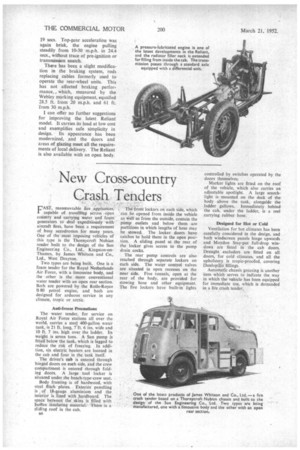New Cross-country Crash Tenders
Page 40

If you've noticed an error in this article please click here to report it so we can fix it.
L'AST, manoeuvrable fire appliances, capable of travelling Across open country and carrying water and foam generators to deal expeditiously • with aircraft fires, have been a requirement of busy aerodromes for many years. One of the most imposing vehicles of this type is the Thornycroft Nubian tender built to the design of the Sun Engineer:ng Co., Ltd.. Kingston-onThames, by James Whitson and Co., Ltd., West Drayton.
Two types are being built. One is a foam tender for the Royal Netherlands Air Force, with a limousine body, and the other is the more conventional water tender with an open rear section. Both are powered by the Rolls-Royce B 80 petrol engine, and both are designed for arduous service in any climate, tropic or arctic.
Anti-freeze Precautions
The water tender, for service on Royal Air Force stations all over the world, carries a steel 400-gallon water tank, is 21 ft. long, 7 ft 6 ins, wide and 10 ft. 7 ins, high over the ladder. Its weight is seven tons. A Sun pump is fitted below the tank, which is lagged to reduce the risk of freezing. In addition, six electric heaters are located in the cab and four in the tank itself.
The driver's cab is entered through hinged doors on each side, and the crew compartment is entered through folding doors. A large tool locker is situated under the bench-type crew seat.
Body framing is of hardwood, with steel flitch plates. Exteribr panelling is of 18-gauge aluminium and the interior is lined with hardboard. The space between" the skins is filled with Wines insulating material: 'There is a sliding roof in the cab.
n6 The front lockers on each side, which can be opened from inside the vehicle as Well as from the outside, contain the pump outlets and below them are partitions in which lengths of hose may be stowed. The locker doors have catches to hold them in the open position. A sliding panel at the rear of the locker gives access to the pump drain cocks.
The rear pump controls are also reached through separate lockers on each side. The water control valves are situated in open recesses on the near side. Five tunnels, open at the rear of the body, are provided for stowing hose and other equipment. The five lockers have built-in lights
controlled by switches operated by the doors themselves.
Marker lights are fitted on the roof of the vehicle, which also carries an adjustable spotlight. A large searchlight is mounted on the deck of the body above the tank, alongside the ladder gallows. Immediately behind the cab, under the ladder, is a reel carrying rubber hose.
Designed for Hot or Cold
Ventilation for hot climates has been carefully considered in the design, and both windscreen panels hinge upwards and Moydon Stay-put full-drop windows are fitted in the cab doors. Draught excluders are fitted on all doors, for cold climates, and all the upholstery is tropic-proofed, covering Dunlopillo fillings.
Automatic chassis greasing is another item which serves to indicate the way in which the vehicle has been equipped for immediate use, which is demanded in a fire crash tender.




















































































